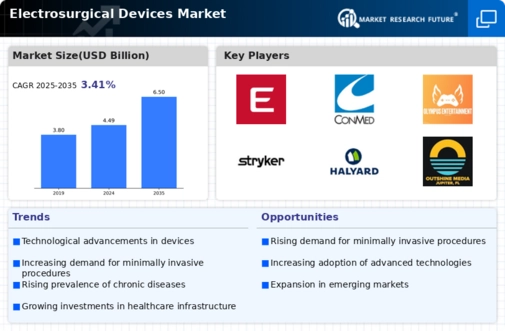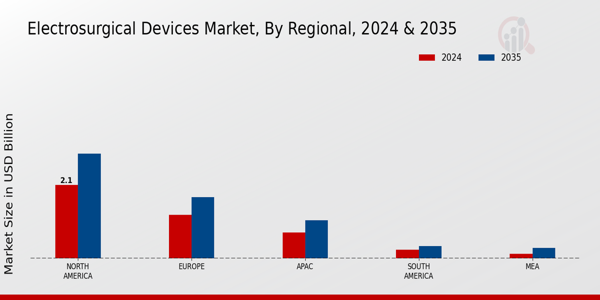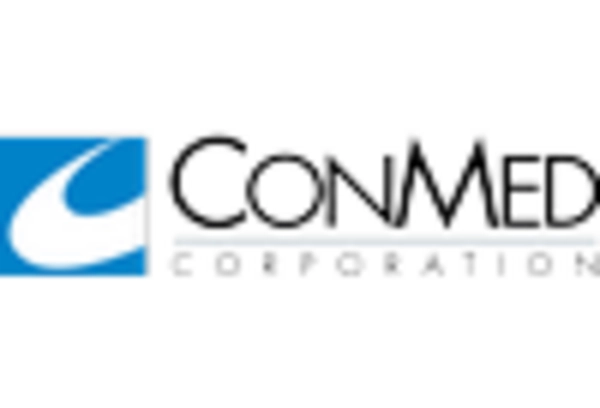Regulatory Support and Standardization
Regulatory frameworks and standardization efforts are essential components influencing the Electrosurgical Devices Market. Governments and regulatory bodies are increasingly focusing on ensuring the safety and efficacy of medical devices, including electrosurgical instruments. This regulatory support not only fosters innovation but also instills confidence among healthcare providers and patients. Compliance with stringent safety standards is likely to drive manufacturers to enhance their product offerings, thereby contributing to market growth. Additionally, the establishment of clear guidelines for the use of electrosurgical devices in various surgical procedures is expected to facilitate their adoption, further solidifying their role in modern surgical practices.
Rising Demand for Electrosurgical Devices
The Electrosurgical Devices Market is experiencing a notable increase in demand, primarily driven by the growing prevalence of chronic diseases and the need for surgical interventions. As healthcare systems evolve, the shift towards more efficient surgical techniques is evident. Electrosurgical devices, known for their precision and reduced recovery times, are becoming essential in various surgical procedures. According to recent data, the market is projected to expand at a compound annual growth rate of approximately 6.5% over the next few years. This growth is indicative of the increasing reliance on electrosurgical methods in both elective and emergency surgeries, thereby enhancing the overall surgical experience for patients and healthcare providers alike.
Growing Investment in Healthcare Infrastructure
Investment in healthcare infrastructure is a critical driver for the Electrosurgical Devices Market. Governments and private entities are increasingly allocating funds to enhance surgical facilities and upgrade medical equipment. This trend is particularly evident in emerging economies, where the demand for advanced surgical technologies is on the rise. The expansion of healthcare facilities is likely to lead to increased procurement of electrosurgical devices, as hospitals seek to improve surgical outcomes and patient care. Furthermore, the establishment of specialized surgical centers is expected to further boost the market, as these centers often prioritize the adoption of cutting-edge technologies, including electrosurgical devices.
Technological Innovations in Electrosurgical Devices
Technological advancements play a pivotal role in shaping the Electrosurgical Devices Market. Innovations such as advanced energy delivery systems and improved safety features are enhancing the efficacy of electrosurgical procedures. The integration of smart technologies, including real-time monitoring and feedback systems, is likely to improve surgical outcomes significantly. Furthermore, the introduction of devices that minimize thermal damage to surrounding tissues is gaining traction. As a result, the market is witnessing a surge in the adoption of these sophisticated devices, which are expected to account for a substantial share of the market by 2026. This trend underscores the importance of continuous innovation in maintaining competitive advantage within the electrosurgical landscape.
Increasing Preference for Minimally Invasive Surgeries
The Electrosurgical Devices Market is significantly influenced by the rising preference for minimally invasive surgical techniques. These procedures offer numerous advantages, including reduced postoperative pain, shorter hospital stays, and quicker recovery times. As patients increasingly seek less invasive options, healthcare providers are adapting their surgical practices accordingly. Electrosurgical devices are integral to these techniques, facilitating precision and control during surgeries. Market analysis indicates that the demand for minimally invasive surgeries is expected to grow, with electrosurgical devices playing a crucial role in this transition. This shift not only enhances patient satisfaction but also optimizes resource utilization within healthcare facilities.


















Leave a Comment